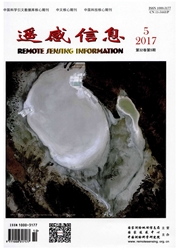

 中文摘要:
中文摘要:
Observations of atmospheric carbon dioxide (CO2 ) from satellites offer new data sources to understand global carbon cycling. The correlation structure of satellite-observed CO2 can be analyzed and modeled by geostatistical methods, and CO2 values at unsampled locations can be predicted with a correlation model. Conventional geostatistical analysis only investigates the spatial correlation of CO2 , and does not consider temporal variation in the satellite-observed CO2 data. In this paper, a spatiotemporal geostatistical method that incorporates temporal variability is implemented and assessed for analyzing the spatiotemporal correlation structure and prediction of monthly CO2 in China. The spatiotemporal correlation is estimated and modeled by a product-sum variogram model with a global nugget component. The variogram result indicates a significant degree of temporal correlation within satellite-observed CO2 data sets in China. Prediction of monthly CO2 using the spatiotemporal variogram model and spacetime kriging procedure is implemented. The prediction is compared with a spatial-only geostatistical prediction approach using a cross-validation technique. The spatiotemporal approach gives better results, with higher correlation coefficient (r2 ), and less mean absolute prediction error and root mean square error. Moreover, the monthly mapping result generated from the spatiotemporal approach has less prediction uncertainty and more detailed spatial variation of CO2 than those from the spatial-only approach.
 英文摘要:
英文摘要:
Observations of atmospheric carbon dioxide (CO2) from satellites offer new data sources to understand global carbon cycling. The correlation structure of satelliteobserved CO2 can be analyzed and modeled by geostatistical methods, and CO2 values at unsam pled locations can be predicted with a correlation model. Conventional geostatistical analysis only investigates the spatial correla tion of CO2, and does not consider temporal variation in the satelliteobserved CO2 data. In this paper, a spatiotemporal geostatis tical method that incorporates temporal variability is implemented and assessed for analyzing the spatiotemporal correlation structure and prediction of monthly CO2 in China. The spatiotemporal correlation is estimated and modeled by a productsum variogram model with a global nugget component. The variogram result indicates a significant degree of temporal correlation within satelliteobserved CO2 data sets in China. Prediction of monthly CO2 using the spatiotemporal variogram model and space time kriging procedure is implemented. The prediction is compared with a spatialonly geostatistical prediction approach using a crossvalidation technique. The spatiotemporal approach gives better results, with higher correlation coefficient (r2), and less mean absolute prediction error and root mean square error. Moreover, the monthly mapping result generated from the spatiotem poral approach has less prediction uncertainty and more detailed spatial variation of CO2 than those from the spatialonly approach.
 同期刊论文项目
同期刊论文项目
 同项目期刊论文
同项目期刊论文
 The response of global net primary productivity (NPP) to CO2 increasing and climate change: Evaluati
The response of global net primary productivity (NPP) to CO2 increasing and climate change: Evaluati Method for Detecting Snow Lines From MODIS Data and Assessment of Changes in the Nianqingtanglha Mou
Method for Detecting Snow Lines From MODIS Data and Assessment of Changes in the Nianqingtanglha Mou 期刊信息
期刊信息
